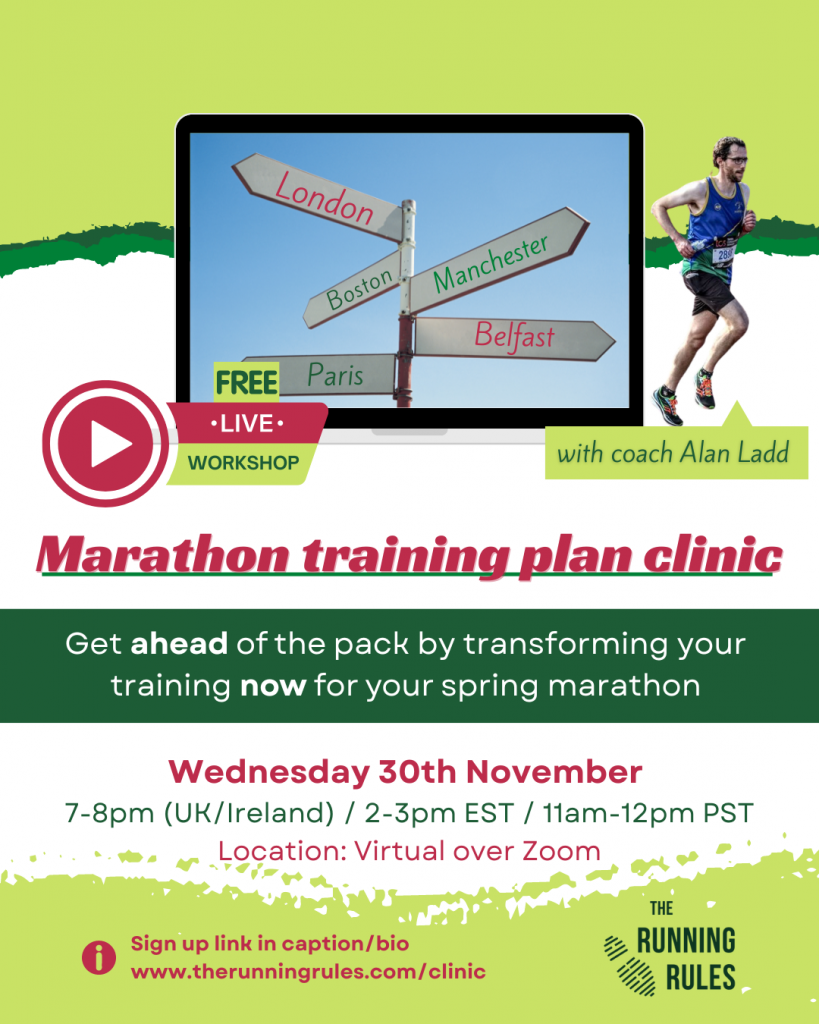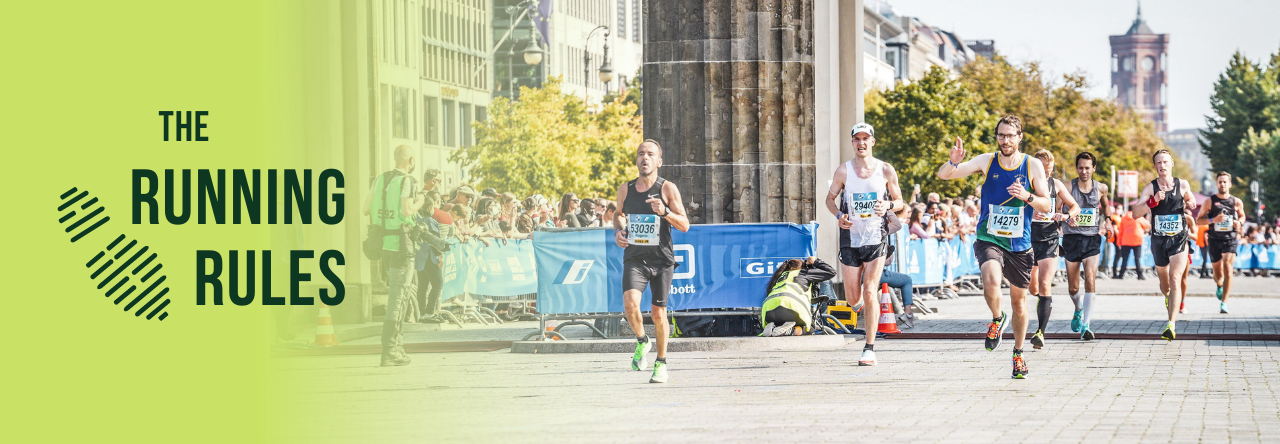
Tag: rules
Run faster, stronger and more confidently
Free running guides
Free nutrition guides
Free pacing planners
Free strava club
Speed = Cadence x Stride Length

There are only two ways to get faster: increase your cadence or increase your stride length. Cadence is how many strides you take per minute. Stride length is the distance travelled per stride. Multiply them together and you will get the distance you cover per minute. Increase either one and the distance covered per minute (i.e. your speed) will increase.
That’s all there is to it. Simples.
Actually it is that simple, but how to do it is not necessarily as easy. The two factors are not independent so increasing one will probably affect the other either positively or negatively. Also, everyone’s build and technique differs, so how do you know which one you should try to increase?
Are you a shuffler or a loper?
At the two ends of the scale are the shuffler and the loper. A shuffler may have a high cadence but a small stride length due to little or no push off from the ground. Imagine sliding your feet out in front of you and doing that as fast as you can. The length of your legs is the limiting factor.
The loper uses a lot of energy to propel themselves in the air and may have a reasonably long stride length but the extra time in the air coupled with overstriding means their potential cadence is greatly reduced.
Overstriding, where the foot lands in front of the body at an angle which is not perpendicular to the ground, applies a braking force to the body (imagine running down a steep hill and actually trying to stop yourself going too fast).
This is a good way to get injured as it increases force through the ankle and knee especially. It also increases the ground contact time which reduces cadence.
The best way to see which you are is to get someone to analyse your technique or video yourself. Check that you are not overstriding by looking at the angle of your foot as it lands. It should be straight and under your body’s centre of mass.
Secondly, look at how far off the ground you push off. If you don’t get far off the ground, you may not be pushing off as much as you could. Of course too much is a waste of energy.
Finally, check your current cadence at a medium/hard effort – something you can hold for an hour. Your training should have a variety of paces included so we want to measure something that is in the middle. When you run faster or slower then cadence or stride length has to change but it’s likely to be a bit of both.
Although there is no hard and fast rule for optimum cadence, most elites are purported to run with a cadence around 180. However, runners have a big variation in cadence depending on many factors so cadences above 200 or lower than 150 are not uncommon.
The point is, the lower your cadence is now, the more room you probably have for increasing it. If you already have a very high cadence, you probably need to look more at improving your stride efficiency to get faster.
I know what I am, but now what should I do?
Knowing which end of the scale you are will help you to know whether you should try to increase cadence or stride length and you may actually have to decrease the other to improve in the long run.
Firstly, if you are overstriding, you should try and correct this. But the easiest way is to try and increase your cadence because, in doing so, it will likely force you to shorten your stride length.
Secondly, if your technique is not obviously at either extreme, try to increase your cadence very gradually but maintain your form. Adding strides to some of your sessions will give you practice at running with a higher cadence.
Increasing cadence is the easier way to get faster but it isn’t the most suitable for everyone. If you know that your cadence is high already and you observe little to no push off the ground, try some running drills like A-skips and bounds to improve your push off. This will help you increase your stride length.
Your cadence may actually drop a little at first as you put more energy into each stride but this will give you more headroom to increase your cadence again later.
If you make any changes to your technique, do it very gradually! Running in an unfamiliar way will put stress on places that aren’t used to it so only do this in small bits.
Keep analysing yourself
Most running watches will provide data for both cadence and stride length. Monitor these on a monthly basis on a similar type run to check for any noticeable changes. Try to video yourself monthly too.
The more you watch yourself, the more you are likely to notice anything out of place. If you’re unsure of what you are looking for then ask a coach or send me an email – I’d be more than happy to help.
Which type of runner are you? What is your cadence? How will you get faster?
Have you ever noticed how your focus or intensity in training tails off when you don’t have a race booked in? Or maybe you had a race booked but you were just running it for fun and so you didn’t really take training very seriously?
Now I am all for enjoying running. Absolutely. If you don’t ever enjoy it then there better be another darn good reason for doing it! And you should definitely have some easy weeks built into your training to avoid burnout.
But I’m also a believer that you need to keep the horizon in your eye-line. You need to know and be thinking of the next big thing for your running. You need a goal that is going to keep you focused and motivated to maintain your fitness.
It could be a special race, a charity event, a faster time, a new distance, terrain or country. It might not have to be a race at all but it has to be something that is big enough for you to have a plan towards.
Planning out at least 6 months in advance keeps you focused on what you need to do to achieve your next target. It will prevent you going onto autopilot and potentially undoing the good work you’ve done up to this point.
Sign up to something today if you haven’t got anything planned. Tell your friends and family to make you accountable and start planning towards your next big goal.
Investing in the stock market always comes with the warning above. However, it applies to running too. It is far too easy to focus on the past and let it cloud our judgement of what we do now. This can manifest itself in two ways: Reminiscent running and Rut running.
Reminiscent running is where we wish that we are as fast and as fit as we used to be. We may wish it so much that we actually believe it until we try running. We then come back to earth with a horrible crash leaving us demoralised and dreading running.
Instead of focusing on where we once were at some perfect point in time, we must be pragmatic and use ‘now’ as the starting point for where we can get to in the future. Start with realistic goals based on your current fitness and work up from there.
Rut running is almost worse. This is where we get stuck doing the same training and our levels plateau. We could see improvements but instead our potential is stunted by doing training that doesn’t work and doesn’t excite us anymore and leaves us feeling stale.
By constantly reassessing our goals and challenges and varying our training accordingly, we stay fresh and keep improving. We conquer new challenges and get the best out of ourselves.
If you are going to invest in the stock market then take the statement above as a caution. However, if you are running take it as a positive reminder not to compare yourself to a former you and that quite possibly your best running days are still ahead of you.
Sometimes it’s very easy to forget why we run. The reasons are different for everyone but there are some common ones that many will share: lose weight; get fit; improve mental health; sense of achievement; meet new people; new experience; set an example to our kids; the list goes on.
However, there may be lots of times when we forget these factors: when the weather is bad; when we feel like we have a bad run or race or sometimes we just don’t feel like running. It’s at these times we need to remember the reasons we chose to do this, especially the most important one.
It may be that we’ve got caught up chasing PBs and we forget that the main reason we run is to be able to eat a few treats guilt free. Or it’s the middle of the winter training for a marathon and the elation of crossing that finish line feels so far off.
A visual or audio cue is a great way to remind us of our reasons for running. It could be a phrase or a picture. It could be before we run or even during the run itself. Pick a short phrase you can recite when things get tough or have a picture that epitomises your why in your kit bag.
If you can’t think of a single reason for why you run then it is possible it isn’t for you and you should think about doing something else. But for almost all of us our personal reasons for running are the single most important thing. They will get us past the toughest points and allow us to enjoy our running more.
If you don’t believe in yourself you will not achieve the things you are capable of. This is not easy for most of us. How do we know that we can succeed at things before we’ve done them? The truth is that we don’t know so we think about it irrationally. We persuade ourselves we can’t go for the goals we dream of and then invariably we talk ourselves out of doing it. We’re scared of failure but actually, not trying is the biggest failure of all.
We look at other people achieving the things we want to and we make up reasons why it is possible for others but not us. Maybe they are ‘naturally gifted’ or they ‘have more time’. What we don’t think about is that maybe they just believe in themselves more. They don’t know any better than us whether they will succeed but they trust in their training plan, lifestyle and work ethic to get where they want to.
Instead of focusing negatively on others, we can use this to our advantage. If these people can achieve their goals then there is no reason why we can’t. Surrounding yourself with people who believe in you too will help. Try and cut out the people who bring you down or try and dampen your expectations. Setting smaller targets to see your progress also helps to build confidence. Combining this with a longer term goal makes the latter less daunting as you see your progress.
The body is capable of far more than we think it is so stop telling yourself you can’t do it and start doing it today.
